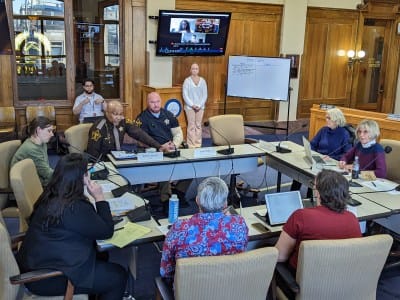Community justice notebook: Committee hears site visit reports, vote likely this week on jail architect

Just after the first of the year, the three Monroe County commissioners made a trip to Arizona to have a look at jail facilities there.

The trip came in connection with the work of the community justice response committee (CJRC), which is the group the commissioners established to address the work of two consultants, which was released to the county government about 20 months ago.
The report described Monroe County’s jail as having “far exceeded its structural and functional life cycle” and pointed to a failure of the current jail to meet Constitutional standards of care.
At the CJRC’s first meeting this year, just after the Arizona field trip, other committee members voiced their dissatisfaction with the lack of a heads-up given about their trip by the commissioners. One source of complaint: Had other members of the committee known, they might have been able to send along specific questions to be asked.
Commissioners told other committee members they would report out on what they’d seen in Arizona. The contentious character of the next few committee meetings meant that the report on the Arizona trip did not get addressed until this Monday.
County councilor Jennifer Crossley is a member of the CJRC. As Crossley put it at Monday’s committee meeting, “This has been like the moment we’ve all been waiting for…”
Commissioners Penny Githens, Julie Thomas, and Lee Jones described three facilities they toured in Arizona—one in Maricopa County, another in Yavapai County, and a third one in Pima County.
It was the crisis response facility in Pima County (Tucson) that was the impetus behind making the trip, Githens said at Monday’s meeting.
The Pima County crisis response center is essentially run by Connections Health Solutions, which is a private health care company. Githens described the crisis response center as built on a campus that the county paid for and opened in 2011.
Githens said the crisis response center has a direct hallway to a medical center. On the same grounds is an inpatient mental health center, Githens added.
The Tucson police department can take people to the crisis response center, and generally they’re in and out within five minutes, Githens said. Githens continued by saying that a very quick assessment is done of anyone who arrives, and a decision might be made to admit or refer someone to the medical center.
A big difference between the crisis response center in Tucson and the Stride Center in Monroe County is the existence of the mental health facility to which arrivals at the center can be admitted.
CJRC member and circuit court judge Catherine Stafford characterized a similar hypothetical facility in Monroe County as “essentially a state mental health hospital, but maybe more functional and locally based.”
Stafford wanted to know what the next step might be for determining whether Monroe County has the ability to pay for something like a locally-based mental health hospital.
At Monday’s meeting, the committee did not have clear answers to Stafford’s question. County councilor Peter Iversen mentioned two pieces of pending legislation that would help some, but would not address the whole problem. Those bills are SB 1 and HB 1006.
On the whole, Monday’s CJRC meeting was less contentious than the last few have been.
But dissatisfaction with the way previous meetings unfolded was still the topic of some public commentary.
Maqubè Reese, who is president of the Monroe County Branch of the NAACP, reprised some of the themes in remarks delivered at the previous CJRC meeting by Nicole Bolden, who addressed the committee as the president of the Monroe County Black Democratic Caucus.
This Monday, Reese told the committee, “We are compelled to express our disgust and frustration with the disrespectful treatment that councilwoman Jennifer Crossley and sheriff Ruben Marté have been subjected to” at meetings of the CJRC.
As the only people of color on the committee, Reese said, Crossley and Marté “deal with enough outside of this space, simply because of the color of their skin.” Reese described the disrespectful treatment as including “rude tone and comments, microaggressions, dismissive body language and gaslighting by commissioners Penny Githens and Lee Jones.”
That stands “in direct opposition to the spirit of collaboration that should be evident in these types of settings,” Reese said.
Expected later this week at the Wednesday morning meeting of the county commissioners is a vote on the selection of a design-build firm to handle the jail’s master planning and eventual design.
A committee that reviewed responses to the request for qualifications (RFQ) recommended that DLZ be selected—from the three companies who responded—to design and build the jail.
The RFQ review committee consisted of: Richard Crider, Monroe County’s director of facilities; David Gardner, ASI Facilities Services contractor; Lee Baker, county attorney; Kyle Gibbons, jail commander; Matt Demmings, assistant jail commander; and Angie Purdie, administrator for the commissioners.
The RFQ process got a mention during public commentary at Monday’s CJRC meeting. Seth Mutchler pointed out that the text of the RFQ issued by the county says: “The committee will request presentations from each submitter, these presentations will be open to the public and may include a public display/presentation.”
Mutchler said the presentations had taken place, but they were not open to the public. Mutchler asked the commissioners to delay their vote on the selection of a jail design firm.
Mutchler said, “I call today for the county commissioners to not vote on any design firm until both the public and public officials have had an opportunity to weigh in, and there is a consensus on next steps.”




Comments ()